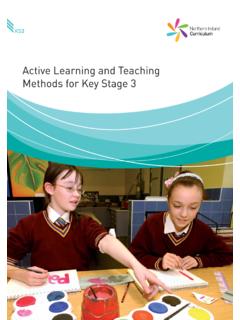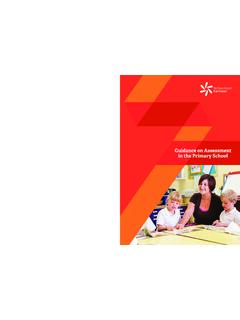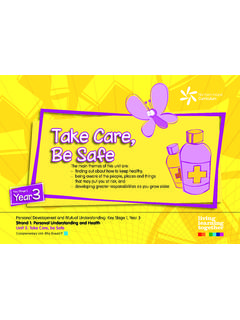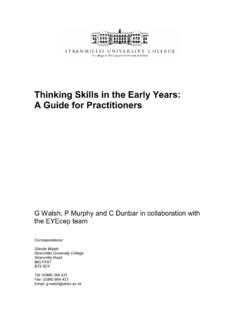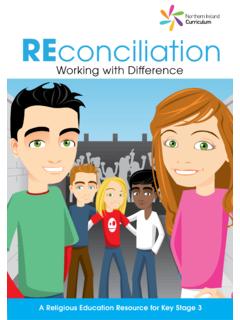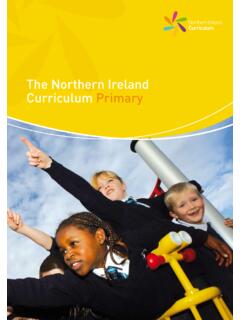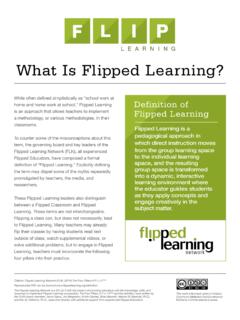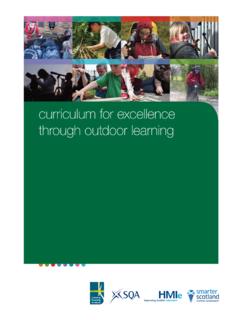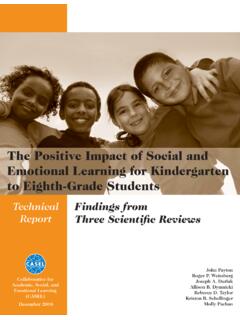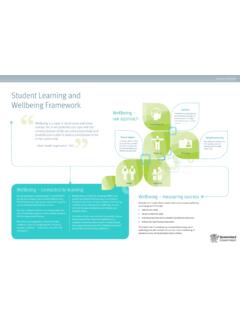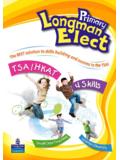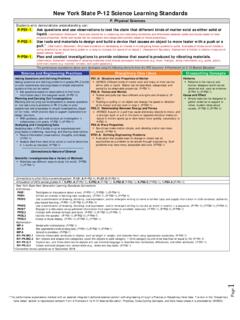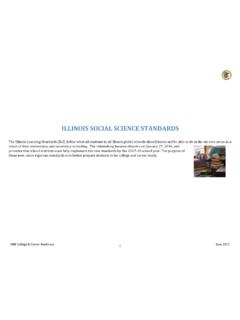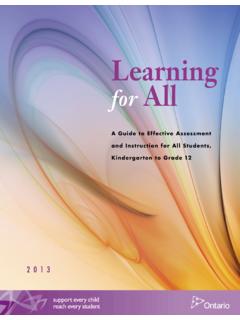Transcription of LEARNING THROUGH PLAY - Curriculum
1 LEARNING THROUGH PLAYin the early yearsLEARNING THROUGH PLAY INTRODUCTION3 CONTENTSI ntroduction4 LEARNING THROUGH Dramatic Play11 LEARNING THROUGH Sand Play25 LEARNING THROUGH Water Play55 LEARNING THROUGH Dough and Clay Play81 LEARNING THROUGH Table Top Play93 LEARNING THROUGH Small World Play105 LEARNING THROUGH Construction Play123 LEARNING THROUGH Creative Play153 LEARNING THROUGH PLAY INTRODUCTION4 This booklet has been compiled by the Early Years Interboard panel in response to requests bypractitioners in Early Years settings for guidelines on provision and progression in methodology and suggested progression in this document is appropriate for the proposedFoundation Stage as recommended by is proposed that teachers will use this resource as a starting point for their own hope you find it Years Interboard PanelDawn CrosbySEELBN uala HeaneyWELBUna CrosseyNEELBAnne McDermott SEELBLiz CroweBELBM arilyn WarrenBELBC lare DevlinSELBLEARNING THROUGH PLAY INTRODUCTION5 ACKNOWLEDGEMENTSThis resource was designed and compiled by members of the Early Years Interboard Panel.
2 We are particularly grateful tothe following teachers for their contribution:Doreen O Neill St Joseph s Nursery Unit SELBP atricia Dunne St. Eithne s Primary School WELBL ornette McAlister Abercorn Primary School SELBH azel Harris Gracehill Primary School NEELBWe would like to thank the Assistant Senior Education Officers of the five Education and Library Boards for theirencouragement and for their financial Interboard Panel is also grateful to officers at CCEA for their technical support in the design and production of the you also to those schools who allowed us to include photographs of play sessions:Ballymoney , Black Mountain , Bligh s Lane , Downpatrick , Dunclug , Glenwood , Kylemore ,Magherafelt , Omagh County , St. John the Baptist and Trinity , a special word of thanks to Lorraine Noble (SEELB) for her endless patience and her faultless word-processing THROUGH PLAY INTRODUCTION6A RATIONALE FOR PLAYOur thinking about play has been influenced over the years by the work of many educationalists,psychologists, researchers and practitioners, and much has been written about how youngchildren learn and how adults can support this the opening chapter of her book Early Childhood Education , Tina Bruce traces this history ofresearch from Rousseau and Kant in the 18th century, the 19th century practitioners like Froebel,Montessori and Steiner, and on THROUGH to 20th century thinkers like Piaget, Vygotsky and this point in time our knowledge base is being challenged further by the work of HowardGardner, Ferre Laevers, Loris Malaguzzi.
3 Chris Athey and has emerged from all of this thinking is a set of common principles to which all early yearspractitioners can sign THROUGH PLAY INTRODUCTION710 COMMON PRINCIPLES OF EARLY YEARS EDUCATIONT hese principles underpin our Early Years Curriculum and guide our planning. Well-planned andwell-resourced play activities which allow for progression in a child s thinking and understanding canprovide the context in which these principles become the reality for all our The best way to prepare children for their adult life is to givethem what they need as children2. Children are whole people who have feelings, ideas andrelationships with others, and who need to be physically,mentally, morally and spiritually Subjects such as mathematics and art cannot be separated;young children learn in an integrated way and not in neat,tidy Children learn best when they are given appropriateresponsibility, allowed to make errors, decisions and choices,and respected as autonomous Self-discipline is emphasised.
4 Indeed, this is the only kind ofdiscipline worth having. Reward systems are very short-termand do not work in the long-term. Children need their effortsto be There are times when children are especially able to learnparticular What children can do (rather that what they cannot do) is thestarting point of a child s Imagination, creativity and all kinds of symbolic behaviour(reading, writing, drawing, dancing, music, mathematicalnumbers, algebra, role play and talking) develop and emergewhen conditions are Relationships with other people (both adults and children) areof central importance in a child s Quality education is about three things: the child, the contextin which LEARNING takes place, and the knowledge andunderstanding which the child develops and BruceLEARNING THROUGH PLAY INTRODUCTION8 WHAT IS PROGRESSION?Progression in play reflects the observation and assessment of children s knowledge, skills andattitudes in order to provide developmentally appropriate experiences.
5 Children come topre-school already as skilled learners. THROUGH our observations, assessment and professionaljudgement we gain valuable insights into how each one learns best. This information informs ourplanning to meet the needs of each individual child. Progression in play comes about as a resultof a real understanding of the interests, needs and experiences of the practitioners, we need to understand that there must be a progression in the provision ofactivities to meet the developmental needs of THROUGH PLAY INTRODUCTION9 THERE ARE 2 STRANDS OF PROGRESSION WHICHIMPACT ON EACH OTHERE xperimental Play Child says What is this? Child plays alone Child plays with little organisation Child moves material or equipment from one area to another orspreads over floor indiscriminately Child builds up and knocks down construction material Child explores properties of materials stacking, balancing,rolling, pouring, filling, pushing, pulling Child displays little or no language or conversation related tomaterials or equipmentMaking and Doing Child says What does this do?
6 Child builds recognisable structures with a purpose which aremeaningful to them series of towers, bridges, horizontal andvertical structures (names given to structures) Parallel play is evident Child begins to solve problems of balance, shape, distance Conversation relating to material developing among the childrenThere are two important aspects to extending quality play. extending the provision the nature of the adults role interacting, facilitating Children need help to extend their play. Adults can contribute to thedevelopment of abstract thinking, for example, by adding resourcesand props, by asking open-ended questions and posing 1 Strand 2 Progression in LEARNING (knowledge & understanding, skills and attitudes)Progression in Provision(extending experiences and resources; the adult s role) LEARNING THROUGH PLAY INTRODUCTION10 Imagining and Thinking Child says What can I/we do with this? Child involved in group planning and organisation Child builds more complicated structures roof and windows Child uses props, signs, labels Child uses a variety of resources in an imaginative way Interest is often maintained for several daysThe Role of the AdultsThe adults will facilitate the progression in LEARNING by planningappropriate will: Support children in their play Provide good quality resources Be aware of the potential LEARNING in all areas of the Curriculum Model skills involved in play Interact with the children, asking questions and making suggestionsto support their LEARNING Be familiar with key vocabulary model and support children intheir use of key words Work alongside children, modelling skills and attitudes Read with children from fiction/non-fiction books, plans, instructioncards etc.
7 Scribe children s ideas and thoughts, and display their work Observe children s LEARNING and use of the provision Assess children s development/progress to inform planning forfuture learningStrand 1 Strand 2 Progression in LEARNING (knowledge & understanding , skills and attitudes)Progression in Provision(extending experiences and resources; the adults role) LEARNING THROUGH DRAMATIC PLAYin the early yearsLEARNING THROUGH DRAMATIC PLAY13 DRAMATIC PLAYD ramatic Play gives children the opportunity to Express themselves Explore language freely Explore feelings and find out about themselves and others Develop co-operation, care, consideration and control Exercise choice and make decisions Use mathematical language and develop mathematical concepts Develop a range of motor skills Use their skills to make the things needed for their play and adapt as necessary Explore a fantasy world of their own creationLEARNING THROUGH DRAMATIC PLAY14 THE DEVELOPMENT OF DRAMATIC PLAYIt used to be thought that children s dramatic play developed THROUGH similar stages to that of other forms ofplay.
8 Onlooker Solitary Parallel Co-operativeIt has been shown that each of these types of play is evident at each stage of development and at somestages more of a particular style will imitate the people around them by recreating scenes from everyday life and acting out familiarroles. From this, imaginative play develops as they develop the ability to incorporate narrative into their they grow, their ability to imagine exerts greater influence on the nature of their play. Their play becomesincreasingly complex and the narratives which are created include more characters and imaginary world children create enables them to realize in their imagination the things that cannot berealized in reality. Fantasy play contributes to children s creativity and imagination and should from Supporting Creativity and Imagination in the Early Years by Bernadette DuffyLEARNING THROUGH DRAMATIC PLAY15 RELEVANT LANGUAGE DEVELOPMENTL anguage development runs THROUGH all dramatic play activities.
9 Talking and listening skillsdeveloped THROUGH dramatic play form the narratives which are the basis of reading and to develop reading and writing occur within meaningful contexts in a role role play situations children can experiment with thelanguage they have acquired as well as new vocabularythey are introduced to in vocabulary and use of language is dependent onthe type of imaginative play offered to the THROUGH DRAMATIC PLAY16 LIVING ROOMKITCHENBEDROOM kitchen furniture sink, cooker, cupboard, table,chairs, fridge, microwave, dishwasher, rubber gloves,cups, saucers, cutlery, pots, spice rack, vacuumcleaner, pans, cooking/baking utensils, timer, clock,ice-cube tray, vases, tablecloth, towels, cloths, ironand ironing board, rubber gloves, dusters, brush anddustpan, broom, kettle, apron, toaster, variety ofcontainers, shopping basket, bags, lunch boxes, realfood or play materials representing food, noticeboard, writing implements, recipe books, shoppinglist, first aid kit, hot water bottle, flowers, rackpaintingsornamentsflowerscushionsnew spaperscatdogtelephone and and address bookcataloguesfamily photos, puppets (for use with TV)
10 Bedscotsbed clothesdollssets of dolls clothesall purpose clothing with velcro fasteningshatslengths of materialcloakshangersdressing tablemirrorjewelleryhandbagsshoesvariety of scarvesHome CornerLEARNING THROUGH DRAMATIC PLAY17 FLOWER SHOPRESTAURANT/CAF TAKE-AWAYPOST OFFICE name of caf signs within caf opening timestablechairtable clothkitchen cooking equipmentcups, plates, cutlerystrawsflowersrecipe bookscash registerpictures of foodfood made of dough, foam, commercially producedfoodboard for dish of the dayorder pads pens/pencilsnapkinsplace matsmenumoneycarrier bagsphoneRESOURCES flowers made by children using paper, card,cellophane, found materialsshop signs opening timesdried flowerscommercially produced flowers paper, silk,plasticreal flowers and plantsoasisshopping basketscataloguescash register, moneyprice liststelephoneorder bookcards large, small, message cardswrapping paperpostersbucketsplastic vasesplant sprayersflower potsribbonspressed flowerspost boxpost office uniformsignsleaflets and forms tax, passport, TV licenceenvelopes, paper, penscardsstampslabelswrapping paperparcels of various sizes, weights,scalestelephonestampers and stamp padtill and moneysavings booksforeign currency, stampsmailbagmapsLEARNING THROUGH DRAMATIC PLAY18 TRAVEL AGENTS/HOLIDAYSHOSPITAL/HEALTH CENTREGARDEN CENTRE doctor/nurse uniformambulance driver s uniform/ambulancedoctor s bag/rubber glovesdollsbeds/bedclothesbandages/cotto n woolplastersmedicine bottles, spoonssyringesstethoscopesthermometersol d X-ray picturesold plaster castscrutchesscalesheight measureswaiting areatelephonenote pad/prescriptionsclipboard, get well cardsreference books about the bodyposters/chartsappointment bookfilesRESOURCES desktelephoneholiday posters, destinations, planes.
